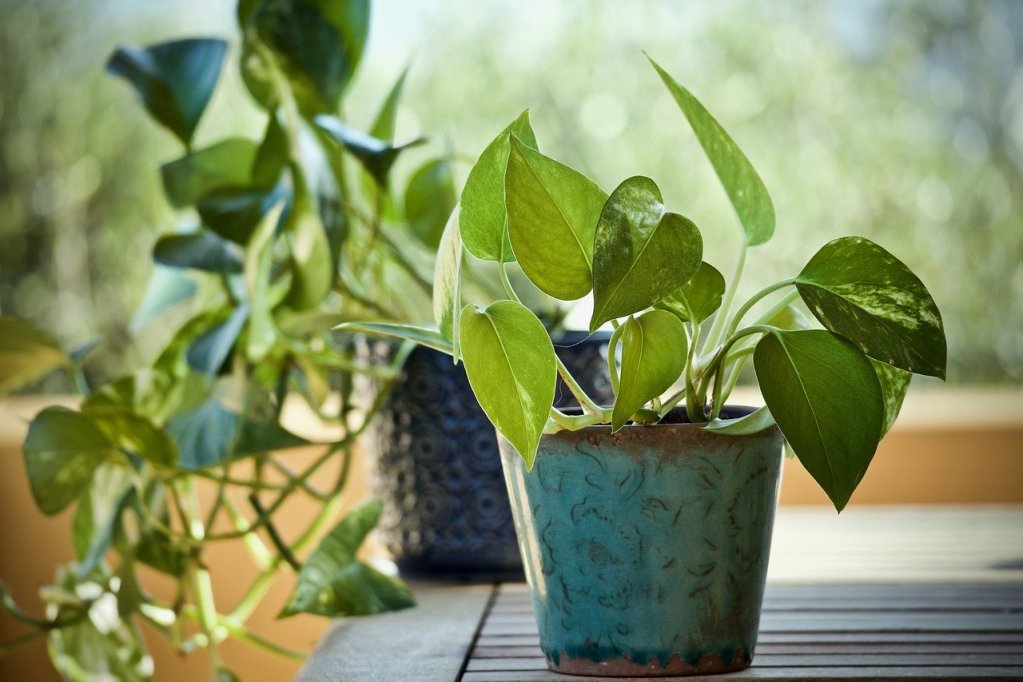Pothos are among the most popular house plants ever. Their elegant vining and easy care are the main reasons almost all plant enthusiasts love this plant. But if you’re a new parent of a pothos, you may have some questions or concerns about proper care. One of the easiest and most common mistakes is providing a pothos with too much sun.
Too much sun?
Pothos’ genus name is Epipremnum aureum, which roughly means “upon the trunk,” as it naturally grows on the trunks of trees near the forest floor. Here, pothos can reach up to 40 feet in length. More importantly, the plant seldom gets direct sunlight. The canopy of the forest trees shade the pothos allowing only medium to low amounts of light. That’s why placing a pothos in a window with direct sunlight can lead to disaster. This will cause the plant’s leaves to yellow, and they might even burn. Over time this amount of sun exposure could kill the plant.
If you’re concerned about exposure, notice whether your pothos is receiving any direct sunlight. If so, move it to a shadier location and use disinfected cutting shears to remove any damaged leaves.
Another sign that your pothos is getting too much sun is if the variegation is losing its contrast. The lighter parts of a variegated plant do not produce enough chlorophyll when exposed to a lot of sun. When Golden Queen Pothos are experiencing too much light, the lovely variegated leaves can become washed out. Move the plant to a low to medium light location and watch the plant for a few weeks to see if the colors come back.
Ideal water and sun conditions
Ideally, pothos love medium light. This means they will thrive in a room that gets bright, indirect light. Whether the window has curtains or allows for light without it being direct, that’s probably an excellent place for your plant. They do well either hanging, trailing, or dangling down cabinets, dressers, plant stands, or in a basket from the ceiling. Plant lovers even use mini Command hooks to trail the pothos vine around the room.
The pothos plant wants to dry out between waterings. The best way to determine if your plant needs to be watered is with a water meter. These affordable devices can be purchased from Amazon, Lowes, Home Depot, or almost any garden center. Users stick the device into the plant’s soil, and the meter will tell you if the soil is wet, moist, or dry. While the finger test works with smaller pots, larger pots can still be wet at the bottom and, if watered again, could cause root rot. Root rot isn’t something to chance since it can kill a plant within days, and there isn’t much gardeners can do to save it.
After determining that your pothos needs to be watered, be sure to saturate the soil thoroughly. When it rains, it pours, and taking your pothos into the shower for a lovely leaf cleaning can be the difference between a surviving pothos and a thriving pothos.
If you can’t take your pothos to the shower, water the pothos until there is water coming out of the bottom of the pot. This ensures all the soil has been soaked and the roots have plenty of supply until the next watering.
How to help a withering pothos
A withering pothos takes the guesswork out of when to water. The plant is telling you with its leaves that it needs a drink. Do not mistake a withering pothos for an overwatered pothos. If you’re unsure, grab your water meter and check the soil. It’s likely going to tell you the plant needs water.
No matter if you’re a seasoned house plant grower or you’re new to the game, there are always going to be questions and concerns that pop up about your plant babies. With as much time, money, and love as we pour into these plants, it’s no wonder we go into a mild panic when leaves turn yellow or start to wilt. Look for the signs your pothos will give you when it needs less light (yellowing leaves) and when it needs more water (wilting leaves), and you’ll have a stunning and thriving plant to show off to all your guests.




